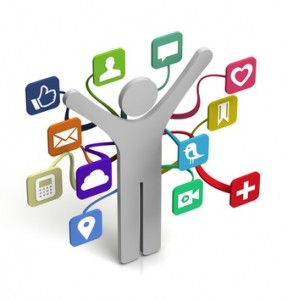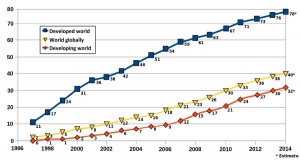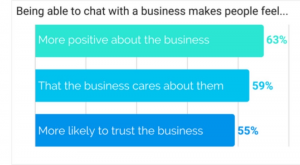
Digital technology has opened up a whole new world of B2B lead generation channels for organizations.
However, not all tools are as effective and efficient at delivering the quality leads you want.
In the perfect world, every B2B marketing campaign you run is successful and every B2B lead generation campaign delivers a plethora of high quality prospects in to your sales funnel. However, that’s not the world we live in, is it?
There is a tonne of information (good and bad) out there about how to get more B2B leads. Today’s buyers are much more sophisticated and clued-in than ever before as you will see from the research below from Forrester and SiriusDecisions. And B2B marketers are slowly starting to take the approach that has been used by B2C marketers for some time now.
The one thing you must always ask yourself is “what is the purpose of lead generation?” Lead generation is all about bringing the right people in to your sales funnel. And chances are that each of those prospects will all be at different stages of the buying process when they arrive.
Here are four digital strategies that can deliver better results from your B2B lead generation activities.
Focus on Traffic from Social Media
Unless you have a large team of people to manage your social media marketing, it is a mistake to even attempt to be on every possible platform with social media. First, a concentrated effort to leverage the B2B lead generation capabilities of a few tools is much more effective. Beyond that, as Neil Patel states, driving traffic to your website should be a core objective of using social media.

Most B2B marketers will agree that you have to implement a customer-centric approach when it comes to your marketing efforts. A blanket approach is not the path to take. People are on different social media channels because those channels deliver a different experience for the user. So if you can avoid it, don’t push the same message out across all of your channels. You need to tailor your messages based on who people are and what they are interested in.
Using Twitter for brand awareness is a useful way to deliver your message and there are a range of automation tools out there to help you ensure you have regular content. But essentially you need to use it to engage with your audience and generate traffic. However, you need to ensure that the content you are pushing is good enough so that people will want to come back to your site on a regular basis.
LinkedIn offers a number of efficient lead generation features. With an audience of 414 million and counting as of February 2016, 100 million of whom use the platform on a monthly basis, it has to be the number one platform for B2B sales and marketing teams.
LinkedIn has a very strong search function where you can search for prospects based on job roles and a range of other factors, which is great if you are a sales person looking for new prospects. But I prefer networking through groups, which is a fantastic facility for driving engagement from prospective clients. Posting regular content that will be of value to readers is also a great service to avail of but don’t overdo it.
Facebook also has some nifty opportunities through event registration, sign-up forms and very granular audience targeting. YouTube offers the ability to show off your products and services, or position your company as a thought leader in its field (see the Forrester video below), and is the second most used Search Engine by people, so you need to ensure your videos are tagged correctly.
A personal favourite of mine is Google+, and one of the key reasons I like it apart from the community vibe that resides within it, is its close affiliation with Google from an SEO perspective. You have lots of choice out there and the key is to focus your time on activities that drive leads to your business.
Continue to Use Email
Despite periodic efforts to tear it down as an “old technology” for lead generation, email remains highly effective. In case you missed it, I wrote about this previously in my post “Why Telemarketing Trumps Email for Lead Generation“. This point is especially true when using marketing automation features common in customer relationship management software.
Using data gathering and analytics, marketing teams can more precisely develop campaigns that target the right prospects with the right messages. Sales teams can also set up automated campaigns that deliver messages at predetermined intervals. A call-to-action specific to the needs of the target recipient can contribute to clicks on your site and getting new leads that you can nurture over time.
If used correctly, email marketing can be a very powerful medium for staying in touch with your prospects until they are ready to engage with you more directly.
Solve Problems with Content
Content marketing has become a top element of digital B2B lead generation. It includes precisely crafted messages in such forms as articles, white papers, ebooks, and videos, that are helpful or valuable to the reader.
The most successful content marketers consider the problems and motives of the prospective customers they’re targeting. Content outlines a problem or concern from a prospect’s point of view, and presents resolutions. Optimising articles for search engines can increase the eyeballs that see content. To generate leads, though, you need a strong story that appeals to the interests of the intended reader.
Content syndication is an important extension of a content marketing strategy. It is the delivery of your content through other websites or publishers. You can manage syndication yourself, but another option is to hire a company that specialises in this method of distributing your message through the right channels that hit your target audience.
An important part of content strategy is knowing the types of content and delivery channels that work best in your B2B industry.
According to a research paper by SiriusDecisions “Demand Creation: Planning Assumptions 2015”, inbound marketing tactics that include strategies such as content syndication are responsible for driving more than 70 percent of enquiry volume for many organisations.
Engage People Directly
As important as the tools you select, you must engage your audience directly. Success on Twitter and other social media, for instance, is usually sparked by inviting reactions to your content and replying to prospects that do show an interest. This engagement process leads to conversations, and potentially a meeting. I’ve often used this method for engaging with people on a one-to-one basis, and been extremely successful with it.
Social Selling
This online engagement has become what we all now know as “Social Selling”. Ultimately, it’s about building relationships.
The challenge sales people have is using it in a manner that will add value to the buyer – from the start of the buying process. But it is a skill that all sales people need to learn – and learn quickly. If you are not using social selling on a regular basis, you are behind your best competitors.
SiriusDecisions have also stated that 70 percent of the buying process is now complete by the time a prospect is ready to engage with sales. Sales is changing and unless you are willing to change your methods, you, my friend, are going to get left behind.
Employee Advocacy
I also believe that sales has moved outside of the realm of just the sales person. It’s no longer good enough for a company to rely solely on the sales guy to be responsible for sales. It is also the responsibility of each and every person working in the organisation – starting at the top. And the best way to do that is through employee advocacy. Your teams and peers and bosses should all be engaging on a regular basis with your content and your potential prospects.

In Forrester’s US B2B eCommerce Forecast: 2015 to 2020 they state that “74 percent of B2B buyers research at least one-half of their work purchases online.” As I mentioned at the start, buyers are doing a lot of the work that the ordinary sales person used to do. And they are doing it online via the mediums I’ve written about here in this article: search engines, videos, whitepapers, content, email.
The author of Forrester’s paper, Andy Hoar also revealed that he expected 22% of B2B sales jobs to be gone by 2020.
You, the salesperson, are being replaced. Unless you are in a consultative position with your clients, or are selling complex products or services, you need to change how you engage with your clients.
In their latest video “The Changing B2B Buyer” Mary Shea, Principal Analyst at Forrester shares her latest sales and marketing research about how b2b buyers are empowered with more information than ever before and are educating themselves in going about the buying process as well as how the selling organisation needs to adapt their engagement process to meet the needs of B2B buyers.
This video is 10 minutes long and I recommend you listen to it. If you don’t have time right now, bookmark this page and listen to it in its entirety when you have time. It is well worth 10 minutes of your time. Particularly the piece around the 6 minute mark that talks about what you, as a sales leader, can do in the next two weeks to bring some of these principles back in to your company.
Conclusion
Finding digital tools to use for B2B lead generation is not a problem. There are hundreds in virtually every category. However, you need to develop a strategy and focus on efficiency when selecting the right ones for your business.
As Forrester (and others) have stated already, the B2B buyer’s journey is nearly complete by the time he or she reaches out to your sales department. So your challenge is to ensure you are reaching the relevant audience for your company with the relevant content they require.
Digital & Social Articles on Business 2 Community(63)






